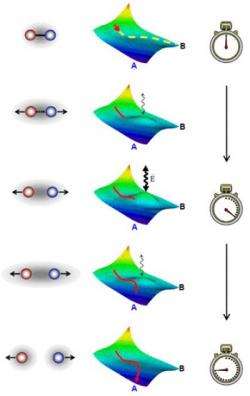New Quantum Technology Controls Molecules

A research team at the National Research Council Canada (Ottawa) has developed a new quantum technology which uses laser pulses to control quantum processes. The method, which is described in the October 13th web release by the world's leading scientific journal, Science, was illustrated by changing the outcome a chemical reaction.
Quantum technologies make use of the molecular scale properties of matter. At this scale, which is different from our everyday world, matter behaves according to the rules of quantum mechanics. Although the rules are well understood, the tools required to control quantum processes are still under development.
Quantum technologies aim to manipulate molecular scale behaviour, in a way not usually seen in nature, for fundamentally new applications. For example, methods to implement quantum information/computation (i.e. computers based upon quantum rules) are the subject of an international race to harness the power of this new technology. Another example of quantum technology is the control of chemical reactions using laser light, the example chosen by the NRC researchers to illustrate their new approach.
A chemical reaction, in which a starting molecule is converted to a product, follows path that seems to a molecule like a hill it must 'ski' down, as shown in the figure. Here a molecule would normally react by heading down the hill towards valley B. The NRC team describes an experiment that is analogous to the 'Labyrinth' game in which a player controls the tilt of a board in order to guide a steel ball through a maze of holes; in this case a molecular scale game. The knob the researchers used is an ultrafast laser pulse (shown here as a wiggly black arrow) which re-shapes the hill (or tilts the board) as the molecule is sliding down the slope, using an interaction called the Dynamic Stark Effect.
In this molecular 'Labyrinth' game, the interaction deflects the reacting molecule towards valley A rather than valley B. The breaking of the chemical bond associated with this process is illustrated on the left. A key aspect of the NRC approach is that the molecule does not absorb the laser light during this re-shaping. The absorption of the laser light would be equivalent to moving the molecule to a different hill instead of tilting the one it is on. This would generally lead to products other than the A or B products indicated in the figure. The avoidance of light absorption is important because different molecules absorb different colours of light, so it is impossible to find an absorption method that works the same for all molecules. Thus, the new NRC method of 'tilting the hill', based on the Dynamic Stark Effect, should be applicable to control of a broad range of quantum processes.
According to Albert Stolow, the NRC team leader, the tool used to alter molecular landscapes has implications beyond the control of chemical reactions. One example already mentioned is in the area of quantum information either to directly encode molecular scale information or to control molecular scale switches.
Another application is in developing novel forms of optical microscopy of live cells, where quantum control methods can be used to sharpen images, enhance sensitivity and perhaps even perform molecular scale surgery on individual cells. The electric interaction underlying the NRC technique is an essential tool on the quantum mechanic's workbench. Its application to science and technology could reach deep into the quantum world of the ultrasmall.
Source: National Research Council Canada





















